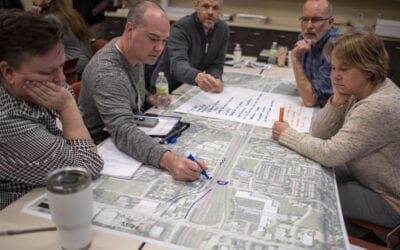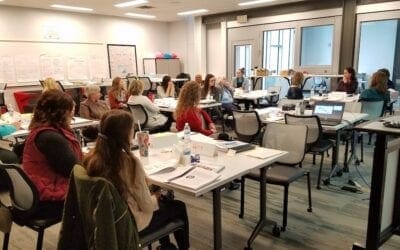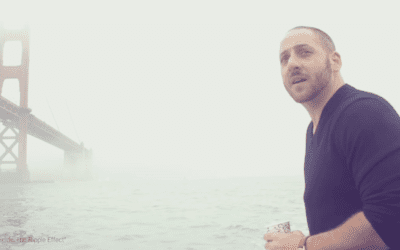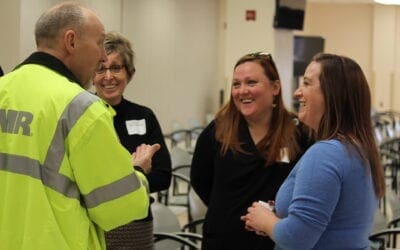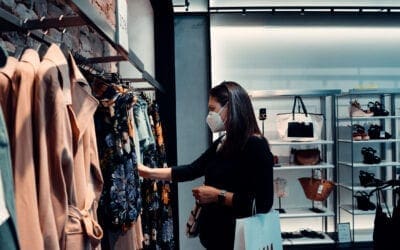Celebrating 100 Years of Building Community Through an Interactive Display
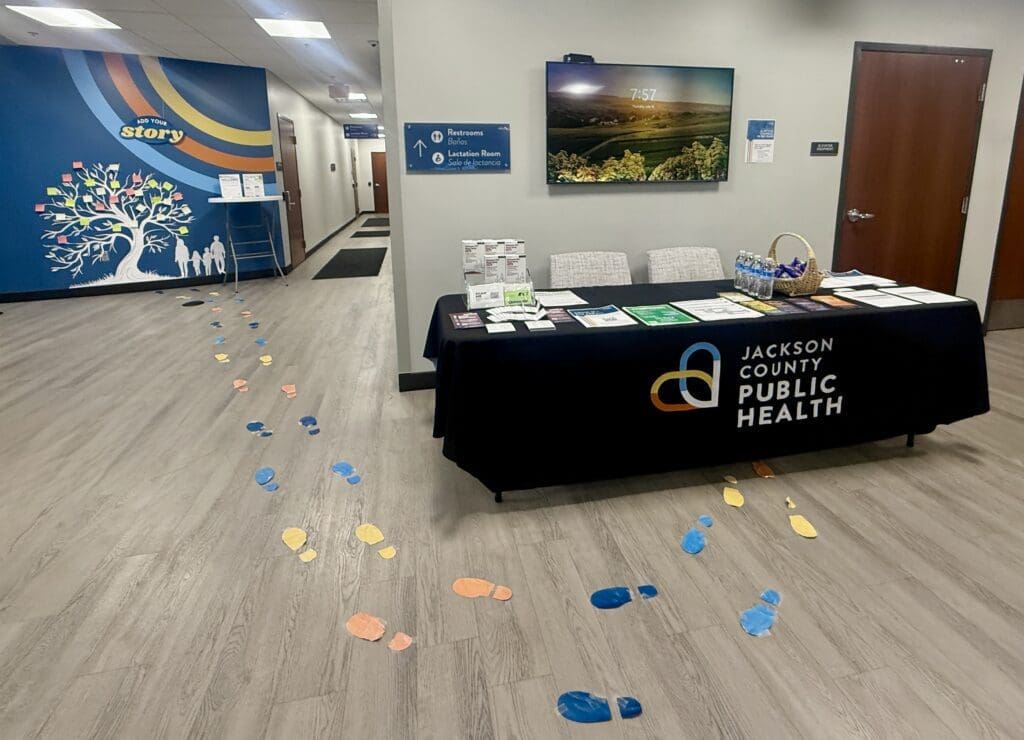
Written by: Makayla McClenahan, Summer 2025 JCPH Communications Intern
Public health isn’t just what happens inside a clinic—it’s woven into the everyday choices we make to care for ourselves, our families, and our communities. Whether it’s staying home when you’re sick, checking in on a neighbor, or getting a flu shot, these small actions build a stronger, healthier, and more connected world.
At Jackson County Public Health, we believe public health starts with people. And when people come together, communities thrive.
A Blank Wall, a Big Question
When I started my internship at Jackson County Public Health this summer, I knew I wanted to work on something that felt personal and community focused. As the department prepared to celebrate its 100th anniversary, I kept coming back to one question:
How can I show that public health isn’t just something that happens in buildings, but something shaped by our everyday actions?
That’s where the idea for the interactive display began.
Building a Space for Community Voice
With the goal of highlighting how public health is more than just a place, I titled the interactive display 100 Years of Building Community. This project was designed to get people thinking and talking about what health means to them today and what they hope it will look like in the future. I wanted visitors to reflect on how public health has evolved over the past century while also recognizing how much potential there still is for progress. My goal was to show that public health touches every part of our daily lives.
It all started with a blank wall, a stack of sticky notes, and a series of meaningful questions I hoped would spark thoughtful reflection:
- What does a healthy community look like to you right now?
- One change I want to see is…
- What is one message about health that you think more people should know?
- What was the health advice you got as a kid, and how does that compare to what it is now?
- In the next 100 years, I hope we have…
- What healthy habits or traditions have been passed down in your family or culture?
- I hope my children or grandchildren grow up in a community where…
These questions were just a starting point. What mattered most to me was creating a space where everyone felt welcome to share.
The Power of Low-Barrier Participation
One of the biggest challenges was figuring out how to invite everyone in—regardless of age, background, or comfort level. I wanted the display to be something anyone could walk up to and feel like they were a part of because community health starts with community voices.
In order to try to bridge this gap, I provided bilingual materials in Spanish for visitors who are not native English speakers. The tree was designed at a height accessible to both children and adults. Additionally, I incorporated bright, engaging colors to attract attention and developed questions that were appropriate and easily understood by all age groups.
That’s how the display came together. It was made to be simple and open—no prep, no sign-up. Just a few minutes to stop, think about the questions, and write down or draw whatever came to mind.
Pairing Storytelling with Support
To complement the display, we set up a resource table offering free Narcan kits, COVID-19 tests, fentanyl test strips, and information about our programs and services. This part was especially meaningful to me.
Coming into this internship, I had a general idea of what public health involved, but I quickly realized just how broad and impactful the field really is. JCPH does so much to support the community in ways that often go unnoticed. That realization made me think, if I wasn’t fully aware of everything public health encompasses, others might not be either. That’s why creating something that could inform, and spark conversation felt so important.
Over the past 100 years, so much has changed at Jackson County Public Health, and it’s essential that people stay informed about the latest resources and support we offer to everyone in our community.
The display inspired some heartfelt responses from people as they interacted with our team while tabling. I’d love to share a few of those stories.
Story 1: A Life-Saving Conversation
While JCPH staff were tabling, they spoke with someone who had never heard of resources like Narcan or fentanyl test strips but had a friend who’d overdosed and was still at risk. They were incredibly grateful to learn these lifesaving tools exist and are available for free. They left with Narcan, test strips, information cards, and a clear plan to help their friend. They were also excited about other local events and programs and mentioned wanting to share the information with others they know.
What really stood out was that they appreciated having someone there in person to talk to. They hadn’t planned to approach the table on their own—it was only because the staff invited them over that they were able to have that conversation. It was a fortunate moment, happening at the very end of the day’s tabling shift, but it made a meaningful difference.
Story 2: A Curious Retired Nurse
Most people were there for appointments, but one person came in specifically to check out the resource table after seeing it on social media. They were a retired nurse and interested in learning more about what JCPH offers, especially travel vaccines. Staff tabling had a great conversation with them, answered their questions, and sent them off with some free snacks.
All in all, this is why having conversations and doing the small things, like tabling, are so important, because they can make a real difference in people’s lives.
Stories like this show why personal connections matter, and that’s why I added a virtual part to the event, to reach even more people.
Extending the Conversation Through Social Media
Even though the display was physically located inside Jackson County Public Health, I didn’t want the impact to stop at the door. Throughout the week, I shared photos and updates on Instagram and LinkedIn to keep the conversation going.
By extending the project online, people who couldn’t visit in person could still respond to the prompts, leave virtual sticky notes, and feel like they could take part in something meaningful.
It showed me just how far a local message can reach and how stories can spark connection no matter where they’re shared.
What I Took Away
Looking back, this internship wasn’t just a project. It was a turning point. It pushed me to think differently, to lean into creativity, and to see the bigger picture of what public health can really mean. It challenged me to step into unfamiliar territory and trust the process, even when things felt uncertain. In the end, it showed me how something simple like a wall, a question, and a sticky note can spark something much bigger.
Throughout it all, I felt truly supported by the JCPH team. They trusted me to take the lead, encouraged me to try new ideas, and gave me the space to bring this vision to life. That trust and encouragement made all the difference.
What’s Next?
As Jackson County Public Health looks to the future, I hope this display is just the beginning. We need more spaces like this, where people are invited to reflect, contribute, and feel seen.
Public health isn’t just about providing care. It’s about listening to the people we serve and designing systems that reflect their realities. If there’s one thing I’ll take with me from this experience, it’s this:
Real progress happens when we make space for people to be heard and let their stories shape the future.
One note at a time.
Makayla McClenahan is a marketing specialist and graduate student at Missouri State University with experience in strategic planning, social media strategy, and public health communication. Connect with her on LinkedIn.
Explore more of our 100 Years campaign at jcph.org/100-years.
Archives
- December 2025 (1)
- November 2025 (2)
- September 2025 (1)
- July 2025 (2)
- June 2025 (3)
- April 2025 (2)
- February 2025 (1)
- January 2025 (2)
- December 2024 (1)
- September 2024 (2)
- August 2024 (2)
- July 2024 (1)
- June 2024 (1)
- February 2024 (1)
- July 2023 (1)
- March 2023 (1)
- October 2022 (1)
- September 2022 (1)
- August 2022 (1)
- July 2022 (2)
- June 2022 (2)
- May 2022 (1)
- April 2022 (4)
- March 2022 (1)
- February 2022 (1)
- January 2022 (1)
- December 2021 (4)
- November 2021 (3)
- September 2021 (2)
- August 2021 (3)
- July 2021 (2)
- June 2021 (1)
- May 2021 (2)
- March 2021 (1)
- December 2020 (6)
- November 2020 (8)
- October 2020 (4)
- September 2020 (7)
- August 2020 (3)
- July 2020 (11)
- May 2020 (2)
- April 2020 (4)
- March 2020 (1)
Categories
- Communicable Disease (5)
- Clinical Services (19)
- Clinical Servcies (1)
- Health Promotions (74)
- Emergency Preparedness (8)
